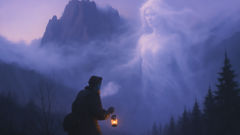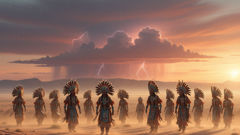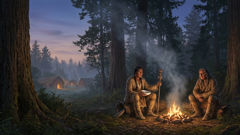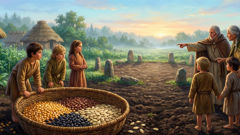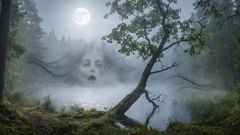Introduction
High above the treeline, where the world narrows to wind and stone and the clouds press like a second shoreline against the mountain peaks, the Vila were born. Not born in any human sense, perhaps, but named into being by the first shepherds who saw a woman step from a bank of vapor and trace a path across the crags as if the air itself were a bridge. Their hair fell in shimmers like drizzle at dawn, and their laughter spread over gullies and spruce like spring water over pebbles. In the villages that huddled in the mountain shadows, people told stories of these figures with voices grown husky from smoke and old wool: tales of healing hands, of songs that could still a fever, of visions spoken at the lip of a thundercloud. They told, too, of a terrible fidelity—the Vila would protect the mountains and the ways the rivers ran, and harm those who felled sacred trees or stole eggs from eagle nests. This is not a single tale of a lone encounter but a braided account, a mosaic of song, law, and warning. It gathers voices from low pastures and high spires, from the rough hands of woodcutters to the taut strings of shepherd flutes. Each fragment holds scent and color—the wet smell of peat, the copper of late light on birch bark, the taste of cloud in a child's first mouthful of rain. To read these stories is to step close to the ridge, to feel the cold slide up through your boots, to stand where the world thins and listen for voices that are half-wind, half-woman. In them the Vila appear as healers and oracles, as ferocious guardians and mournful hosts; sometimes they dance a mortal awake, sometimes they ride the thunder and scatter a warband. The following pages gather their appearances—how they came to be known, how they dealt justice, and how echoes of their rule survive in songs and superstitions carried down the valleys. This is a careful telling: rich in detail, shaped by place and time, attentive to ritual, and honest about fear.
Birth of the Vila: Mountain Air and Cloudsong
The first part of the Vila's tale begins with landscape, and to understand them is to understand those places that made them: a band of mountains that seem to forget the plain behind them and lift into cloud, a place where weather writes in thick, abrupt sentences and springs can appear where none were yesterday. In the medieval memory of the villages, the Vila have no single origin story. Some say they were daughters of the first storm, spun out of lightning and rain by the hands of an old sky-god who wanted companions to watch the high passes; others say they are the souls of unwed women who chose the great heights rather than marriage and were taken by the mountain. A more pragmatic telling, sung by shepherds who know the names of every ridge, suggests the Vila are less born than made: when a place is loved to excess—when children have been baptized in its brook, when elders have died with its scent in their hair, when flocks have grazed upon its grasses—then the place keeps that love and becomes inhabited by guardians. The Vila are the names given to that keeping.

Across different valleys, their physical descriptions change with the weather. Farther north, they appear as pale figures, hair braided like frost and skin like the inside of an oyster shell. In the southern foothills they have darker eyes and coppery hair, and their laughter smells faintly of wild thyme. Their clothing, when they wear clothing at all, is woven from cloud and dew—long veils that stream in the gusts and skirts whose hems are threaded with lichen patterns. In some songs they carry birch rods in their hands; in others they carry nothing and yet command the wind. What remains consistent in every account is a sense of aside—Vila are the measure of a mountain's mood. When the ridges are kind, the Vila are kind; when the people break oaths, the Vila answer with a hardness that matches the granite they haunt.
The earliest written traces of Vila imagery come from later medieval scribes who collected oral tales. Those collections are inflected by monastic pens, of course, and the Vila are sometimes folded into Christian cosmology as fallen spirits or as dangerous fae. Yet, in the oral record, Vila are neither evil nor wholly benign. They are jurors of a kind, interpreters of balance. A willow left uncut by a family that had once sheltered a wandering Vila might be rewarded: sheep return to lamb on good nights, children recover swiftly from fever. Likewise, a family that hacked down a sacred pine to feed a forge might find their well runs bitter and their harvests thin. The balance they guard is not purely ecological though; it is social. Vows—between lovers, between kin, between neighbor and neighbor—are sworn on particular stones and springs. If someone willfully breaks such a vow, the Vila's response is prosaic and sharp: a sudden wind that scatters a caravan, a night of wrong-headed illness, a dream of garments soaked in blood. Conversely, promises kept beneath a certain linden will be remembered by the Vila for generations, and the living may later call upon that memory in days of need.
Ritual makes Vila presence legible to human communities. Shepherds leave a bit of bread under a flat stone on the high paths, or they hang a ribbon on a birch to mark gratitude after a safe crossing. Women who expect a child might go to a high spring and whisper the child's name to the mist, asking the Vila for a safe delivery. These acts are not bargaining so much as acknowledgement. The Vila, as the old songs insist, are not sellers of favors; they are keepers of continuity. A song collected from the eastern slopes tells of a woman named Agata who, having been healed of a fever by a Vila touch, sank into the grass and hummed a lullaby for the mountain. The lullaby, according to the song, is what kept the Vila from leaving their crag for a generation.
Beyond ritual, the Vila teach with pedagogy of risk. Many tales describe their lessons delivered in storm: a woodcutter who fells an ancient yew finds himself lost in the mist until he recognizes the name of the tree aloud; a hunter who kills a white doe thought to be a Vila's emissary returns to discover his way had been stolen and his hounds deafened. These narratives function, in part, as ecological cautionary tales. They formalize rules: do not cut the marked grove, do not herd through a mead in spring when the young grass is tender, do not lie where vows are kept. The punishments are as practical as they are poetic. A broken promise may not lead to an overtly supernatural punishment but to social exile: the village will not buy your bread, or your marriage prospects vanish. The Vila do not always mete out supernatural vengeance themselves; sometimes they incite or bless social processes so that human communities do the remembering and the punishing.
Language itself is shaped in Vila regions. The mountain dialects keep words for specific forms of mist and different kinds of wind, words for the direction of a cloud-hinge and the manner a stream remembers a path. Folk songs include refrains addressing the Vila directly: "Sister on the ridge, keep our lambs, keep our path," they sing. These refrains make the Vila present in ordinary life, like the name of a river or the taste of the first spring water. And in the hush between two stanzas, there is always the possibility that a Vila listens and answers—by a sudden clearing in the clouds, by a child sleeping through a fever, by the soft sound of silver hoofs that may or may not belong to any beast.
So the birth of the Vila is not a single event but a slow accretion: place after place, vow after vow, the will of landscape hardened into a collective personhood that the people could address. When they speak of the Vila, they speak of guardianship born of mutual care. Their songs and practices ensure that human communities keep the mountain's features in mind—the birch that marks a boundary, the spring used for midwifery, the hollow where the eagles nest. In this sense, the Vila are less like remote divinities and more like the conscience of a place, giving voice to what might otherwise be unrecorded and ensuring that the mountain remembers its own shape through human memory.
Encounters and Oaths: Healing, Prophecy, and Wrath
When people speak of meeting a Vila, they usually mean an encounter that tilts the border between the human and the supernatural. Encounters vary in texture and consequence—some are brief and almost anonymous, a flash of pale arm in a fogged pass; others last for days, a string of odd events that rearrange a household's fortune. The nature of these meetings is pragmatic in the valleys: the Vila heal certain wounds and illnesses, and the remedies they offer are often carried back into human practice. The Vila's healing is not universally benevolent or easily purchased. It springs from attention and reciprocity. One recorded tale tells of an old woman, Marfa, who lost her sight in a scalding. She sat on the high ledge and called the name of a known Vila as the custom suggested. The Vila appeared, traced a wet palm along her eyelids, and left Marfa with a blurred but usable vision. In return, Marfa learned a blessing for the spring and vowed to lead children there to sing the spring's name aloud every year. This exchange—healing for ritual witness—is repeated across narratives.
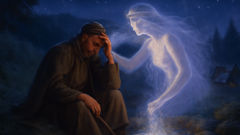
The Vila's prophecies are another form of aid. They do not typically unravel the future in long scrolls; rather, they disclose moments of possibility. A shepherd who dreamed of a Vila pressing a deer's antler into his palm might understand it as a warning: a winter's early ice could thin the grazing, and the flock should be moved. In a major medieval account, a Vila warned a small hamlet of a fissure in the mountain through a series of birds circling at evening. The warning arrived as a vivid dream to the hamlet's midwife, who organized an evacuation that saved several lives when the hillside finally shed rock in the thaw. These prophecies are often local, specific, and intimately tied to a place's physical needs.
But the Vila's justice is harsh when their boundaries are violated. Stories of wrath tend to be the most memorable because they are dramatic and because they instruct. In the classic tale of the miller who cheated the village, a man named Petrov cuts timber from a sacred grove to build an extension for his mill, wanting to increase his grind capacity and his profits. He scorns the old superstitions and mocks the charms his neighbors place on the well. Within a week, the mill's wheel breaks; his best oxen become lame; and a wind with teeth comes down the valley, shredding his roof. The Vila do not always appear as visible agents; they work through weather and misfortune that human listeners will interpret as moral consequence. Petrov, in despair, seeks out the old woman Marfa, who instructs him to make amends: to rebuild a sapling grove beside the mill and to sacrifice his finest flour to the spring for three years. Whether or not the Vila are satisfied is uncertain in the story—he is forgiven by neighbors only after years of small, consistent acts of restitution.
There are whole classes of Vila stories that are instructive and cautionary without direct supernatural action: tales where the Vila's presence is felt as a social memory. If a bride abandons her promise at a high linden and runs away, the villagers will note the breach and will not choose her family for alliances for two generations. The Vila's power, in many accounts, is made effective by human recognition. This interplay raises interesting questions about agency. Are the Vila autonomous? Or do communities use belief in them as a mechanism for social order? The answer changes by story and by teller. Some narratives insist on the Vila's independent will—they move through the clouds with a purpose not aligned to human law. Others show them as part of a moral ecology: they are invoked, feared, petitioned, and made legible by the people who live with them.
Consider the case of the warrior who tried to capture a Vila. A band of raiders once attacked a mountain hamlet and stole a chest the villagers considered sacred—a chest kept beneath a stone and marked with small tokens of the Villa. The raiders boasted they could take what they liked from mountain folk. At night they were hunted by a fog that smelled of roasted herbs; their torches sputtered and died. Men disappeared as if swallowed by the darkness. Those who returned were found sitting on rocks, humbled, their hands empty and their eyes glazed with fear. The raiders swore they had seen women in the mist whose faces were not human—whose hair was a downpour and whose mouths opened like weather. Even the toughest among them would not return to the mountain for raiding. This story is not merely supernatural horror but an account of how community boundaries were defended when law was weak: belief and fear acted as deterrent and defense.
Healing practices learned from Vila encounters entered folk medicine. A herb rubbed with breath while speaking the Vila's name might be used for binding broken bones; a lullaby borrowed from Vila song could ease a child with convulsions. Some of these remedies likely had empirical value—cold water on a fever, compresses of certain leaves for swelling—yet they were framed within a world where the practitioner's intention and the mountain's approval mattered. The Vila, thus, became partners in practical care and memory-keepers of which treatments had worked and which had failed.
Not all encounters end well, and not all prophecies are heeded. There are stories of lovers who try to steal a Vila's favor by copying their songs and wearing their veils. The imitation fails, and where it fails the consequences are personal: a bride loses the ability to bear children, a hunter's aim is forever skewed. The moral of these tales is more subtle than "do not pretend." It is about authenticity of relation. The Vila's realm, being the realm of air and place, resists human mimicry. You cannot become a Vila by costume alone; you must be known and given over by history and place. The wound for those who lie is not only supernatural but social: being caught in false ritual breaks trust across generations.
Warfare brings other themes. In larger sagas, Vila have been described as combatants—riding the thermals and slashing cloud-forms into storms to scatter troops. Such descriptions are rarer and more dramatic, often appearing in border sagas where mountains served as refuges for brigands or fugitives. A tale of the "Vila of Voron Peak" tells of a night raid saved when winds rose and disoriented an invading band, causing them to fall into a ravine. Survivors believed the winds were guided by women on the ridge who sang in an impossible key. These stories function as metaphoric explanations of weather phenomena and as claims of protection: the mountain will protect its own, sometimes in ways that look like strategy rather than simple malice.
Across these narratives, what is striking is how the Vila's justice is calibrated—not mindless vengeance but a kind of proportionate retribution rooted in the logic of place. They restore balance in a way that reflects an older legal sensibility: compensation, memorial, and ritual restitution rather than annihilation. Yet, because Vila law is not codified in parchment but in song and ritual, it remains flexible and often terrifying in its unpredictability. To live with the Vila is to accept that the landscape holds memory and that memory can be exacting. The encounters remind villagers to be careful stewards, to honor boundaries, and to remember that in these high places the world converses back when addressed with sincerity.
Legacy and Return: The Vila in Modern Russia
As centuries passed, the Vila's stories traveled down from ridges into print and into the national imagination. Their image was reshaped by poets, ethnographers, and the slow churn of cultural exchange. Yet the core of their power—place, memory, reciprocity—remained. In the nineteenth century, collectors of folk song and myth sought out mountain elders and transcribed their refrains. They recorded women's voices humming lullabies to springs and old men singing the names of different kinds of mist. These collectors often framed Vila tales within antiquarian or nationalist projects, using them to argue for a continuous Slavic identity. The effect was double-edged: the Vila gained prestige as national symbols, but their messy and local rules were sometimes streamlined into more marketable motifs: the beautiful nymph who either helps the hero or curses him, depending on his gallantry.
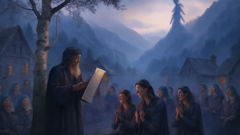
Even so, the living practice of Vila remembrance did not entirely disappear. In pockets of the Caucasus and Carpathian foothills, families still observe small rituals: a ribbon on a birch, a dish of milk left at a particular hollow, a story told to children about why they must not disturb a certain moss-blanketed stone. These practices survive because they work—because they maintain watershed boundaries, protect grazing, and encourage social cohesion. Anthropologists have noted how such customs can be adaptive: they sustain fragile mountain ecologies by inculcating restraint and respect without formal legal enforcement. In an era when timber companies and state projects sometimes erased memory in the name of progress, Vila tales were redoubled by villagers who needed a reason to keep a ridge uncut.
Modern literature and film have reimagined Vila in many ways. Some contemporary poets emphasize their loneliness and their melancholic watching over a world that moves faster now, that dims the old songs with engines and neon. A novel might imagine a Vila learning the names of cars and electric lights, finding new forms of sorrow as the slopes fill with roads. Other artistic treatments return to the Vila's ferocity—calling them to stand against ecological devastation, casting them as avatars who respond to pipeline clearings and illegal logging with a resurgence of storms. These modern Vila are not exactly the same as the medieval figures, but the throughline remains: the mountain's guardians adapt their metaphors to new threats.
At the same time, skepticism grows in towns that no longer rely on oral memory. Young folks move to cities, and the rituals become curiosities. Scholars debate whether Vila stories are literal belief or social metaphor. Some argue that myths like the Vila are tools communities use to regulate resource use and prevent tragedy. Others insist that such an interpretation flattens a living imaginative presence into utilitarian terms. Both views, perhaps, are insufficient alone. The Vila's continued relevance likely depends on a mix: ecological practice, story, and the deep human need to address the unknown in a voice that feels personal.
One of the more remarkable modern adaptations is the ecological oath taken by some mountain communities to protect certain watershed areas. These oaths borrow language from old Vila tales and even borrow performance elements: a child is placed on a rock, the elders speak the names of rivers and promise stewardship aloud. The formal legal weight of such oaths varies, but their cultural resonance matters. They form a bridge between old mythic thinking—"the mountain remembers"—and contemporary environmental ethics: "the land we rely upon will fail if we do not guard it." In some cases, such rituals have helped secure legal frameworks for conservation, with activists using the language of Vila custodianship to persuade policymakers of the necessity of protecting certain habitats.
There are also more intimate contemporary stories of Vila-like encounters. An urban woman who fled to her grandmother's village for a summer reports waking to the sound of a woman humming in the early mist, a sound so old it seemed to belong to the bones of the earth. She was given a small book of folk remedies by an elder who said, with quiet certainty, that the mountain liked her because she had returned. Whether this woman's experience is explained as a fluke of memory and sleep or as an unmediated brush with a living Vila, it functions socially the same way: it reconnects a person to place and to practice. The Vila thus remain a hinge between personal memory and public culture.
Language remains key. Contemporary musicians in Russia and beyond sample field recordings of old Vila songs, loop them, and overlay new lyrics that talk about highways and satellite dishes next to goats. The juxtaposition produces a strange continuity: the old refrain about leaving bread at springs now accompanies an electric bass line. This mixing of registers is not mere novelty; it is how myth lives. Myths are not inert relics; they are materials for new meanings. When a modern composer sings of a Vila's wrath at a clear-cut, listeners hear both ancient danger and a topical protest.
Finally, the Vila's presence in tourism and regional branding complicates matters. Some mountain towns create festivals that commodify Vila imagery—parades of girls in white veils, staged "appearances" in fog machines, souvenir veils sold in stalls. That commercializing trend is met with ambivalence. On one hand, festivals revive interest in old songs and get younger people to ask their grandparents about rituals. On the other hand, there is a fear the Vila will be turned into kitsch and that communities will lose the deeper discipline and reciprocity their stories once codified. The best outcomes are those where the Vila's stories are used to reawaken stewardship rather than simply to attract visitors.
Through all these changes, the Vila's essential lesson endures: place remembers, and to live well in a landscape one must learn how to be remembered by it. The practice of leaving offerings, of reciting names, of moving flocks prudently—these are small acts of humility in the face of a world that is powerful and indifferent. The Vila teach patience and respect in a voice that can be gentle as a spring's laughter or terrible as a storm. They remind us that human life is always entangled with more-than-human forces and that culture itself is one way of giving those forces a name. To encounter a Vila, modern or medieval, is to be addressed by a landscape that refuses to be mere backdrop and insists on its own claims.
If the Vila are, in the end, guardians of memory, then they are also models for a mode of living that listens. In our era of rapid change, their stories—beautiful, formidable, and exacting—offer a set of metaphors for how to treat the world: with curiosity, with ritual, with restitution when wrongs are done. They teach that justice can be local and embodied: repair where you have broken, plant where you have cut, speak aloud where silence has been convenient. The Vila's voice may be a fog on a high ridge or a line in a poem, but its call is pragmatic and persistent: the mountain keeps its own, and those who would live in these places must answer.
Conclusion
To close this telling is not to seal the Vila away in museum glass but to keep the conversation open. Their stories teach practical stewardship, offer solace and warning, and present a way of thinking about landscape that mixes ethics with memory. Across medieval hilltops and modern conservation meetings alike, Vila narratives ask us to remember how a place has been treated and to repair the harm done. They are not only myths but civic and ecological tools: a heritage of songs and signs that help keep water clean, soils rich, and neighborhoods bound. When a villager ties a ribbon on a birch today, she speaks the same language as her grandmother did under a different sky; when a composer borrows a Vila lullaby for a protest song, she extends that language into new urgency. The Vila are at once ancestors and contemporaries, a chorus that keeps on singing as long as someone will listen. If you ever find yourself on a high ridge and you hear a voice in the fog, take the small, human acts seriously: leave a scrap of bread, say a name aloud, keep the promise you made in the valley. In doing so you enter into a long tradition of reciprocity that has sustained mountain people for generations. The Vila will not always show themselves, nor will they always be merciful; but they reward those who remember and are relentless with those who forget. That double edge—grace and rigor—makes them one of the most enduring presences in Slavic myth, and it is why their stories continue to matter in a world where the mountains themselves still need defenders.

